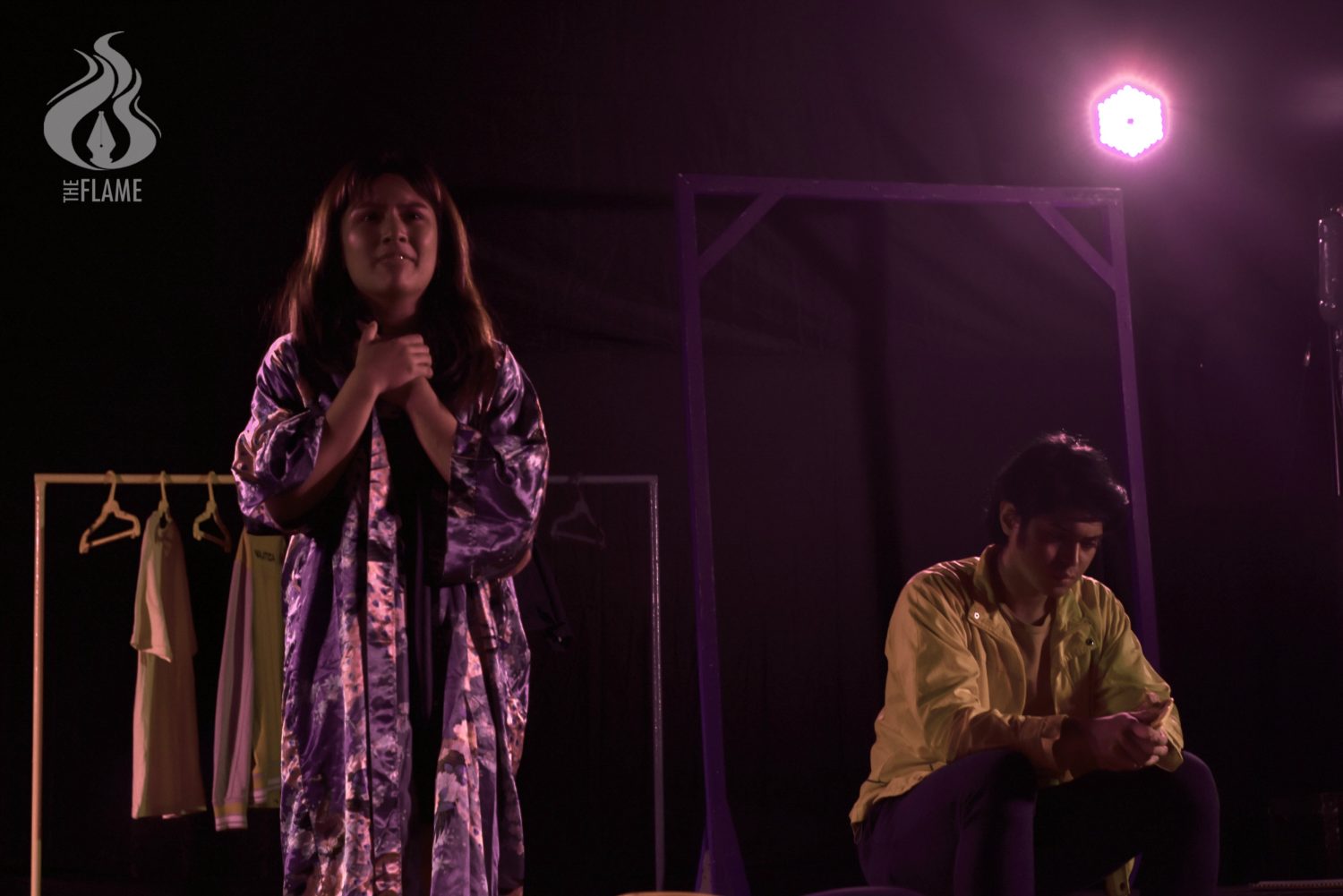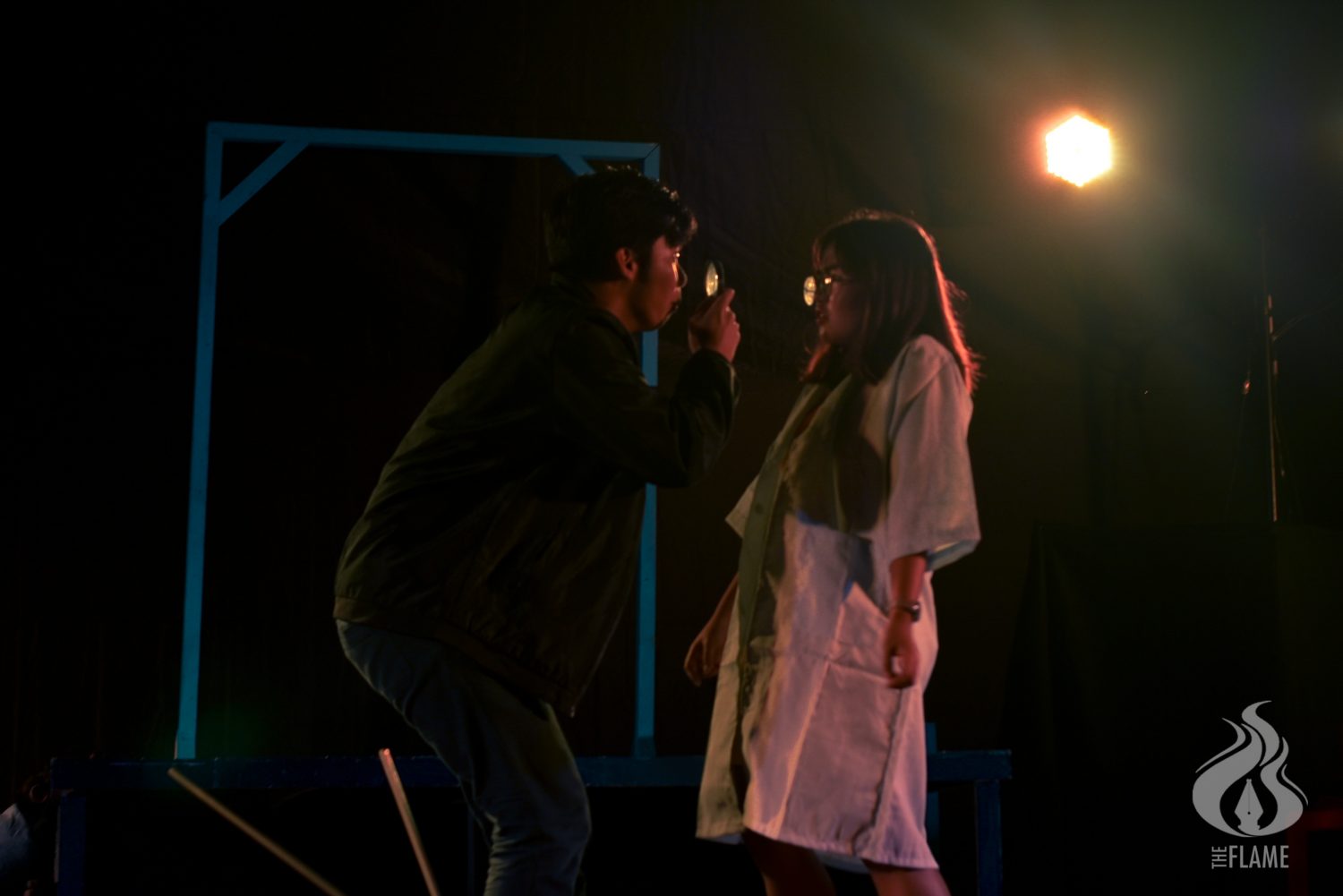By RY PHILIP JACO T. GALVAN

DISTANCE IS measured by how far two bodies or objects are apart. For the romantics, it is measured by how close hearts are to one another. Regardless, distance becomes a mere construct when both parties fight for love together.
In their 39th season, Artistang Artlets proves that they are truly limitless by tackling the underrated importance of levels in their double-bill play, Kalayò. The play features the stories Isang Buwan Isang Araw and Pagdadalaga, both of which were directed by Voltaire Avendaño and discussed an underlying topic of distance and connection.
Isang Araw Isang Buwan

Written by Ivan Gordola, the play tells the story of two star-crossed lovers, Luna (Alyssa Paredes) and Paul (Hans Kho), who meet in a dating site and try to make the stars align to their favor. Many topics were addressed in this play like the concept of “ghosting”, love, finding meaning in life, and the genuineness of intimacy.
The play opens with a sad and lonesome looking girl who the viewers come to know as Luna. The music, light, and space that she inhabits suggests a dark mood that is yet to be resolved. On the other side of the stage, the viewers meet Paul, an eccentric and jolly-looking man. The two of them are paired in a dating site. After a night of chatting about life, galactic bodies and love, the two of them form a strong bond with one another. In one of their conversations, they related themselves to the sun and moon in such a way that no matter how hard they could only be aligned, but never together. The closest they could get is through eclipsing, but it is not enough because they are only aligned, but not together.
Isang Araw Isang Buwan proves to be timely and relevant to the youth of today. It is set in the time of online dating sites, where a phenomena called “ghosting” may occur. The play takes place in two rooms; each of them having a distinct color which separates the characters of Paul and Luna. in their search for love, they struggle in fighting the conditions that plague their relationship.
The simplicity of the act made it easy to digest without actually spoon feeding the audience. One such particular scene is from when Paul and Luna paced around the set. Their movements represented the sun and moon following their course ㅡ at one point, their characters aligned in order to get a glimpse of each other. Another notable part of the play was how well the two leads acted out the chat scenes as they creatively portrayed how even the most simple chats can feature genuine intimacy.
Despite the stellar acting from the actors as shown by their confidence and mastery of the play as seen by how they internalized their characters, along with the savvy story related to modern problems and dilemmas people face today, the play is not saved from technical difficulties. At times, the lighting seemed to flicker, and change hues that do not match the scene’s atmosphere. In key scenes, music complimented the mood of the story: tunes with positive undertones were played with gusto at whenever Paul and Luna chatted. After every sent text, the viewers will hear a ringtone that signifies that one has sent a message. However, the timing of some music cues were a little off and this slightly aggravated the act.
Overall, Isang Araw Isang Buwan is an astounding act that pushes the audience to take the leap and to never give up.
Pagdadalaga

Pagdadalaga, a play written by alumna Jhudiel Sosa, tells the story of a family consisting of a grandmother, Gina (Monica Divino); a middle-aged mother, Pia (Clary Sunga); and a genius granddaughter Nikka (Sophia Eugenio) who is at odds with her family. They live together but are apart in terms of their relationship with each other due to differences in age and generation. The act is set in the family’s home in the 1980’s. It tackles topics such as motherhood, family, and seizing life, presented in a light-hearted dramedy that endears itself to the audience.
It begins with an ailing Gina who celebrates her 70th birthday. As she rests on her birthday, Pia, her daughter, prepares Gina’s favorite miso soup. Nikka, her granddaughter, is reluctant to help; along with her air-headed friend, Owen (Ivan Gordola), she decides instead to work on a science project which can supply electricity to a number of houses. In trying to activate the invention however, it malfunctioned and accidentally turned Gina, who was resting upstairs, into a young woman again. Being back in her youth, Gina tries to make amends with her family by filling the gaps she left when in raising her daughter and her granddaughter. Meanwhile Nikka and Owen were busy finding a way to turn Gina back to normal once again.
In tackling the topic of distance, the production ironically had to deal with a small stage. As a result, they had to use the bottom part of the stage which did not go as well as planned. Some scenes in the bottom area were not visible to the audience, especially to the ones sitting in the middle and front. The blockings, however, gave life to the play and grabbed the audience’s attention. One notable part was when Nikka and Owen were going down to the basement. There, they acted as if the first two rows were flight of stairs, even ducking at make-believe posts.
Pagdadalaga portrayed connection as communication. The lack of time the family had for each other resulted in a near total absence of communication. Thus, each member felt estrange, wandering through their lives feeling lonely and isolated. Dialogue is presented as the foundation for a better relationship, achieved through genuinely speaking and listening to the other person. It creates connection.
The play’s transitions were smooth, providing a clear-cut sequence of events. Some scenes took longer than necessary; but in the end, these scenes proved vital to the entirety of the play. In making the play more lively, the production also used effective stage whispers which produced the desired effect without overshadowing the main performers on the stage.
Kalayò perfectly sums up Artistang Artlets’ theme for the year “Limitless” as they explore the pains and joys of distance. In their play, the use of levels as a way to show power, dominance, and conflict is integrated in the play’s build-up, which provides a deeper introspective in those following details. It also features interesting plots along with developed ad fleshed-out characters, making it worth the watch. F



